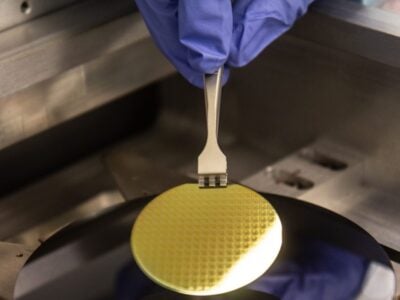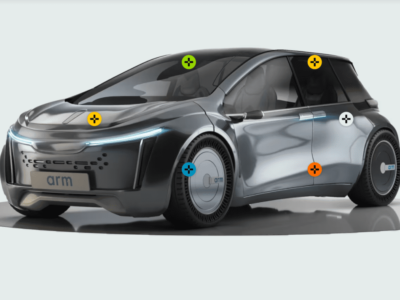
CEO interview: Vesper’s Crowley on piezoelectric MEMS and arrays
eeNews Europe caught up with Vesper CEO Matt Crowley and asked about the prospects for piezoelectric MEMS and whether the time is right for his company move into adjacent markets.
Crowley pre-empted his comments by saying there was no announcement about Vesper getting into speakers and that the complexity of taking a MEMS transducer concept from technology through to product should not be underestimated. He added that it was right that Vesper, as a small company, should continue to focus on bringing MEMS microphones to market.
“We are big believers in peizoMEMS. We are one of the first [to use the technology] and now we are in mass production,” Crowley said. “It is like building a skyscraper. There seems to be a lot of time spent in a big hole making the foundations but once that is done the building shoots up.”
Crowley continued: “We do a have roadmap to improve the piezoelectric material. We use aluminium-nitride although we could also use alternative materials. Piezoelectric transducers do follow a scaling law. If you halve the membrane thickness you can cut the membrane area and die size in half. We continue to invest in the process to reduce the membrane thickness although at present we are using PVD [physical vapor deposition] to sputter aluminium-nitride. But other physical deposition techniques will be applied.”
Crowley said that atomic layer desposition (ALD) is a more expensive process but with much better control and that should allow thinner membranes, which are typically of the order of micrometers rather than nanometers.
“We are working with Globalfoundries but at all foundries MEMS tends to use lagging process technology both in terms of lithography and deposition,” Crowley said. “Aluminum-nitride is a great material and you can use dopants to change characteristics. We are sort of material agnostic. But new materials are going to help increase sensitivity.”
Next: Still a startup
“As a startup we tend to be more prepared to jump on stuff as it moves from research to development,” Crowley added.
Piezoelectric microphones already lead in sensitivity so isn’t ‘good enough’ exactly that?
“In the smartphone market most microphones already meet the broad range of requirements. But there are applications where increased sensitivity would good. Microphones for automatic noise reduction (ANR) headsets is one. And higher sensitivity allows us to trade off sensitivity against die size. Also, once you start making better microphones people come up with applications that can exploit them.”
Crowley gave the example of high dynamic range microphones that can be placed very close to noise sources in industrial machinery and so on. Piezo is useful in such applications because it is also robust against dust.
Another useful attribute of piezoelectric MEMS is that it is a relatively simple add to conventional processes and so allows the integration of multiple types of sensor on the same substrate, Crowley said. He gave the example of including audio and ultrasound detection – or ultrasonic proximity detection with a temperature sensor.
“Ultrasonics is something we could do but again developing a MEMS product is a big project.”
The mention of bringing multiple sensors onto a single substrate raises the topic of arrays as a means to raise performance or alter functionality of MEMS sensors.
Next: Arrays are happening
“Arrays are slowly happening. You inherently get directionality and an increase in sensitivity but particularly with audio you want the elements in the array to be as far apart as possible, which is a countervailing drive.”
But Crowley added that if the customer is prepared to have big die, says two centimeters on a side, or a big FR4-based component it is possible to think of a stand-alone array. Microphones in any case need a reasonable depth of housing to prevent damping of the microphone. Crowley said that customers with certain defense applications in mind have been approaching Vesper about arrays.
However, more general array developments are for the future Crowley said. Right now the company is focused on its zero-power listening microphone which can be used as a fundamental always-on sensor. “It allows the design to be power down completely except for a piezoMEMS microphone and a small listening circuit. Any noise will move the microphone membrane but a threshold can be set to wake up the rest of the MEMS ASIC and then to wake up the equipment. “It is proving of interest in smart speakers, smart remote controls, hearables,” Crowley said.
This underlines that while the smartphone is the largest market for MEMS microphones it does not have the highest growth. There is some growth because gradually the number of microphones deployed in almost equipment is increasing. But the non-smartphone market for MEMS microphone is increasing at 50 percent per annum, Crowley said.
And that’s another reason for Vesper to keep its focus on microphones.
Related links and articles:
News articles:
Vesper raises $23 million for production of piezo mics
Vesper reveals GloFo as microphone maker
Arrays could extend MEMS speaker applications, says USound
Startup Chirp Microsystems to become part of TDK’s InvenSense
 If you enjoyed this article, you will like the following ones: don't miss them by subscribing to :
eeNews on Google News
If you enjoyed this article, you will like the following ones: don't miss them by subscribing to :
eeNews on Google News



